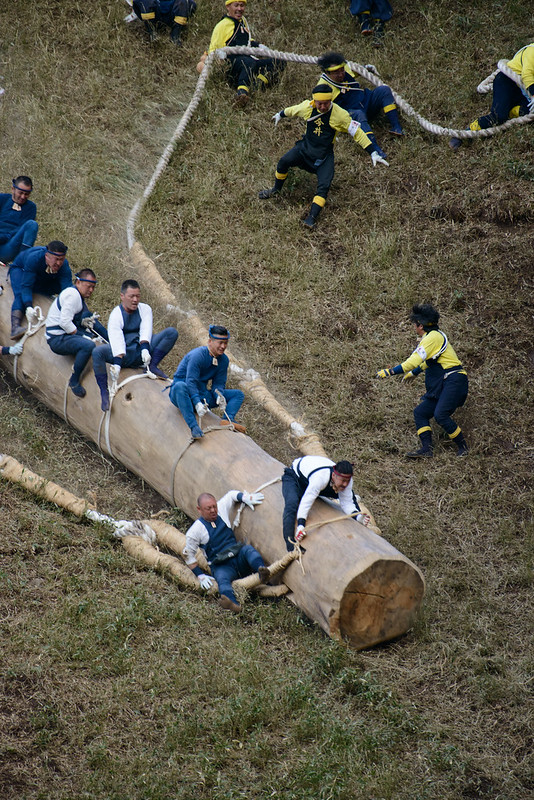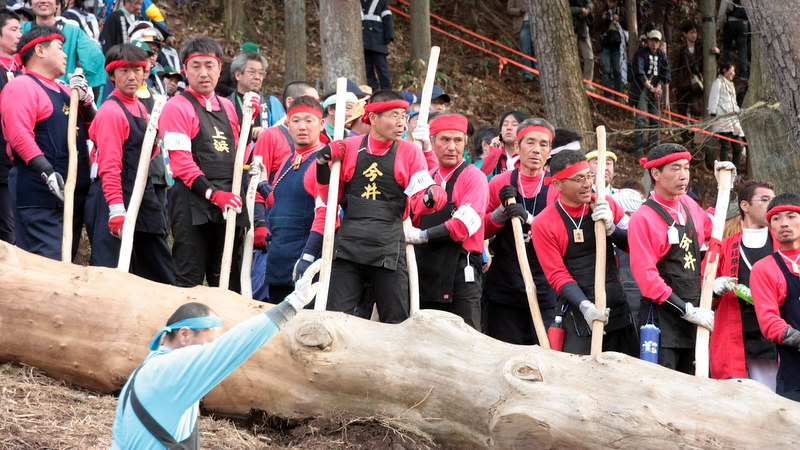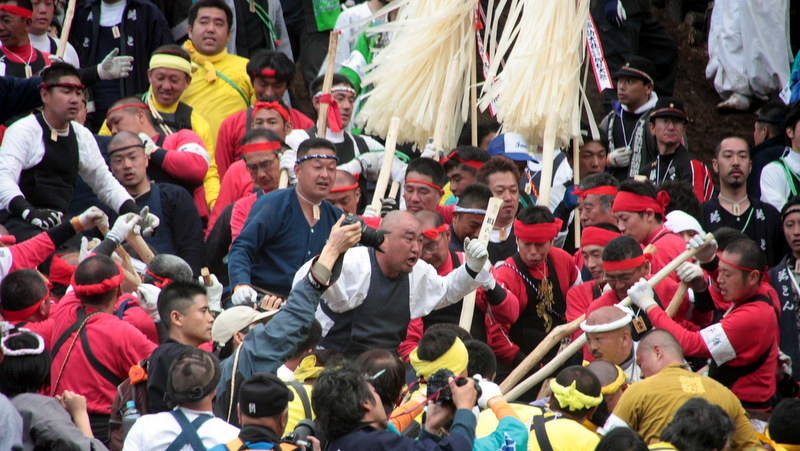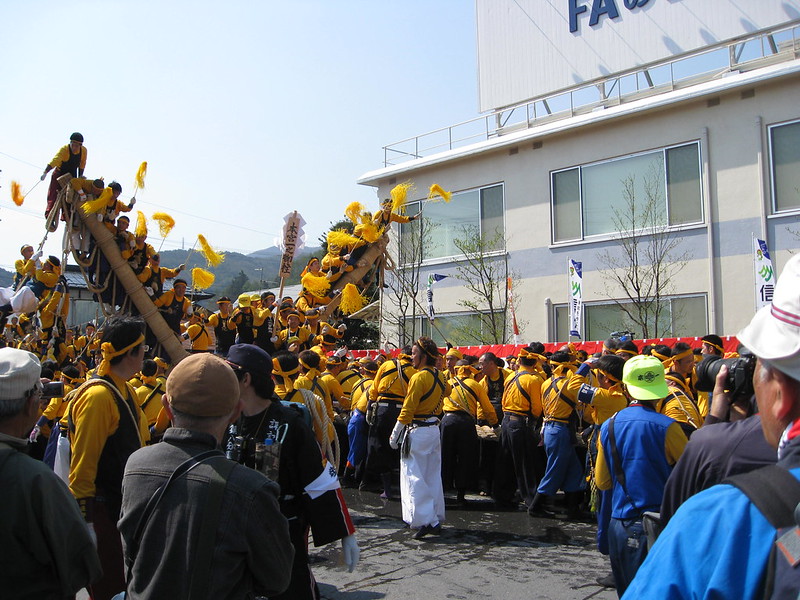Onbashira Matsuri
The Life-Risking Log Drop and Unbreakable Bonds of Suwa’s Grand Festival
2026/04/01 - 2026/06/14
Once every six years, the quiet mountain villages of Suwa in Nagano Prefecture are transformed by the excitement and cheers of the Onbashira Festival. For over a thousand years, this grand event has seen villagers fell enormous fir trees in the mountains, then slide them down steep slopes and raise them at the four corners of Suwa Taisha Shrine. The scent of fresh timber, the earthy aroma of soil and sweat, the thunderous shouts and cheers, and the sight of men risking their lives astride the logs—Onbashira is living tradition that shakes the hearts of all who witness it[1][2][3][5][6][8].
The festival unfolds in two parts: Yamadashi (the mountain descent) and Satobiki (the log-raising), spanning several weeks from April to June. More than 500,000 people from across Japan gather to feel the thrill, spectacle, and pride of the region. If you want to experience one of Japan’s most dynamic and daring festivals, love photography, or seek to feel the heat of culture and community, Onbashira is for you[1][2][3][5][6][7][8].
Main Attractions
Yamadashi (Log Drop)
The greatest highlight is Yamadashi. Dozens of men haul fir logs—up to 16 meters long and weighing over 10 tons—down mountain paths. The climax is Kiotoshi, the “log drop,” where brave riders straddle the logs and plunge down a nearly vertical slope, to the roars and screams of the crowd. The creaking of wood, the smell of mud and pine needles, and the resounding “Yoisa! Yoisa!” chants echo through the mountains[1][2][3][5][6].
Satobiki (Log Raising)
In Satobiki, the logs are paraded through the town with lively music, flags, and costumed participants before being raised at Suwa Taisha using only ropes and human power. When the pillars stand tall at the four corners of the shrine, the crowd erupts in cheers. The sound of bells, the fluttering of flags, and the beat of drums add to the festival’s charged atmosphere[2][3][4][5].
Costumes and Decorations
Participants wear happi coats and headbands in red, blue, and white, with sashes and family crests. White tabi socks and straw sandals are common, and towels are wrapped around hands for grip. The logs are adorned with sacred ropes (shimenawa), paper streamers, and colorful banners, while the route is lined with flags and lanterns[2][3][4][5].
Cultural and Historical Background
The Onbashira Festival has a history of over 1,200 years and is held to renew the sacred pillars (onbashira) of Suwa Taisha Shrine. The acts of felling, transporting, and erecting the logs are believed to invite divine power and pray for the region’s prosperity and safety. For the people of Suwa, Onbashira is a source of family and community pride, a milestone in life, and a tradition passed down through generations[2][3][4][5][6].
Designated as an Important Intangible Folk Cultural Asset, it is a major event that draws national attention as well as local devotion[2][3][4][5][6].
Participant Voices
"I came from Tokyo with friends to see Yamadashi. Mud was flying, everyone shouted together... eating gohei-mochi while cheering, I was more excited than I’ve ever been at any festival."
Fun Facts
- Each onbashira log weighs over 10 tons and can reach 16 meters in length[1][2][3][5].
- The festival is held every six years, in the years of the Tiger and Monkey in the Chinese zodiac[2][5][7][8].
- Kiotoshi, the log drop, is considered one of the most dangerous festival events in Japan[3][5][6][8].
Festival Dates
The Onbashira Festival is held once every six years at Suwa Taisha Shrine in Suwa, Nagano Prefecture[1][2][3][5][7].
The event schedule is subject to change. Please check the official website for the most up-to-date information.
Information
| Name | Onbashira Matsuri |
| Country | Japan |
| Area | Nagano, Suwa Shrine |
| Date | 2026/04/01 - 2026/06/14 |
| Link |
Upcoming Festivals
Whirling Dervishes Festival Turkey
A Mesmerizing Dance of Divine Love
2025/12/06Mevlana Celaleddin Rumi Commemoration Ceremony ( Şeb-i Arus ) Turkey
A Whirling Journey to Divine Love
2025/12/10Dia de la Virgen de Guadalupe Mexico
A Festival Weaving Faith, Fervor, and Mexican Identity
2025/12/11L'Escalade Switzerland
Geneva’s Grand Winter Festival of Courage, Chocolate, and Community
2025/12/12Umkhosi Wokweshwama South Africa
The Zulu First Fruits Festival—A Sacred Celebration of Land, Ancestors, and Renewal
2025/12/12Lucia Festival (St. Lucia's Day) Sweden
A Festival of Light Illuminating the Nordic Darkness
2025/12/15Las Posadas Mexico
The Luminous Quest for Sacred Shelter
2025/12/22Noche de Rabanos (Night of the Radishes) Mexico
A celebration blending art, farming heritage, and cultural traditions
2025/12/23Chant of the Sybil on Majorca Spain
A Medieval Prophecy Echoes Through Majorcan Christmas
2025/12/23‘Hatajo de Negritos’ and the ‘Hatajo de Pallitas’ Peru
A Christmas Festival of Rhythm, Faith, and Afro-Andean Heritage in Peru’s Ica Region



